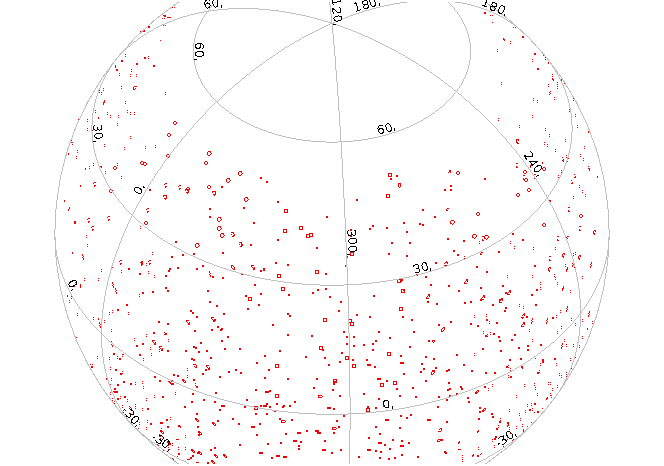
The coverage of the 2007-2012 Antares neutrinos, with positional uncertainties scaled by three.
At our Heidelberg data center, we have have already published some neutrino data, for instance the Amanda-II neutrino candiates, the IceCube-40 neutrino candidates, and the 2007-2010 Antares results.
That latter project has now given us updated data, for the first time including timestamps, available as the Antares service.
Now, if you look at the coverage (above), you'll notice at least two things: For one, there's no data around the north pole. That's because the instrument sits beyond the waters of the Mediterranean sea, not far from where some of you may now enjoy your vacation. And it is using the Earth as its filter – it's measuring particles as they come ”up” and discards anything that goes “down”. Yes, neutrinos are strange beasts.
The second somewhat unusual thing is that the positional uncertainties are huge compared to what we're used to from optical catalogs: a degree is not uncommon (we've scaled the error circles by a factor of 3 in the image above, though). And that requires some extra care when working with the data.
In our table, we have a column origin_est that actually contains circles. Hence, to find images of the “strongest” neutrinos in our obscore table, you could write:
SELECT * FROM ivoa.obscore AS o JOIN ( SELECT top 10 * FROM antares.data ORDER BY n_hits desc ) AS n ON 1=INTERSECTS( s_region, origin_est)
in a query to our TAP service.
But of course, this only gets really exciting when you can hope that perhaps that neutrino was emitted by some violent event that may have been observed serendipitously by someone else. That query then is (and we're using all the neutrinos now):
SELECT * FROM
ivoa.obscore AS o
JOIN antares.data as n
ON
epoch_mjd between t_min-0.01 and t_max+0.01
AND
dataproduct_type='image'
AND
1=INTERSECTS(origin_est, s_region)
On our data center, this doesn't yield anything at the moment (it does, though, if you do away with the spatial constraint, which frankly suprised me a bit). But then if you went and ran this query against obscore services of active observatories? And perhaps had your computer try and figure out whether anything unusual is seen on whatever you find?
We think that would be really nifty, and right after we've published a first version of our little pyVO course (which is a bit on the back burner, but watch this space), we'll probably work that out as a proper pyVO use case.
And meanwhile: In case you'll be standing on the shores of the Mediterranean this summer, enjoy the view and think of the monster deep down in there waiting for neutrinos to detect – and eventually drop into our data center.

![[RSS]](./theme/image/rss.png)